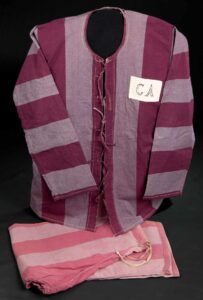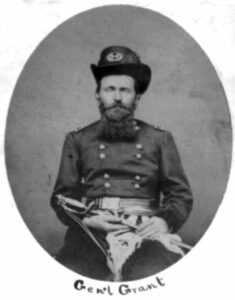by Jim Lankford
On 30 April, 1945 the New York Times reported: “Huge Prison Camp Liberated…27,000 American and British prisoners of war at a large camp at Moosburg.” The report was correct, the camp was huge, but it was also wrong. The following day, the Times printed a correction: “The Fourteenth Armored Division liberated 110,000 Allied prisoners of war at Stalag VIIA at Moosburg, instead of the 27,000 prisoners previously reported. This was Germany’s largest prisoner of war camp.”
On 28 April the 14th Armored Division, commanded by MG Albert C. Smith, crossed the Danube River at Ingolstadt, and passed through the 86th Infantry Division, which had established a bridgehead on the previous day, with the mission of securing crossings of the Isar River at Moosburg and Landshut. Combat Command A (CCA) was on the right of the division’s line of advance, Combat Command R (CCR) was on the left, and Combat Command B (CCB) was in reserve.
Large numbers of German troops were falling back on Moosburg to cross the river. Among them were the remnants of the 17th SS Panzer Grenadier and 719th Infantry Divisions. It was, as it had been for much of the way across France and Germany, a race to capture a crucial bridge before retreating German units got safely to the other side and blew it up in the faces of the oncoming Americans.
Under its commanding officer, BG Charles H. Karlstad, CCA moved quickly towards Moosburg. The order of battle consisted of: the 47th Tank Battalion; 500th Armored Field Artillery Battalion; D Troop, 94th Cavalry Reconnaissance Squadron (Mechanized); C Company, 125th Armored Engineer Battalion; B Company, 68th Armored Infantry Battalion; and B Battery, 398th Antiaircraft Artillery Automatic Weapons (Self-Propelled) Battalion. Total strength of the command was about 1,750 men, including support units. With only one company of infantry at its disposal, the combat command was significantly understrength in infantry.
The combat command advanced nearly fifty miles on 28 April, against sporadic resistance. CCA Headquarters settled in for the night at Puttenhausen at 2300 hours. The main force, including the 47th Tank Battalion and the infantry of B Company, 68th Armored Infantry Battalion (B-68 AIB), was eight miles to the southeast at Mauern, only four miles from Moosburg. The entry into Mauren had not been an easy one. Just before midnight, the infantry went in ahead of the tanks to clear the town, and were ambushed by SS soldiers using machine guns and automatic antiaircraft guns. The enemy resistance was eliminated in a short but intense fire fight. B-68 AIB lost several men before the town was finally secured. (See map above)
During the early morning hours of the 29 April, a car approached a roadblock on the southeast side of Mauern from the direction of Moosburg. The car was not fired on as it was seen to be flying a white flag. In the car were four men who asked to speak with a senior officer. They were escorted to LTC James W. Lann, the commanding officer of the 47th Tank Battalion.
The party included a representative of the Swiss Red Cross, an SS major, COL Paul S. Goode, USA, and Group Captain Willets, RAF. The latter two were the senior American and British officers from Stalag VIIA, a prisoner of war camp near Moosburg. COL Goode had commanded the 175th Infantry Regiment, 29th Infantry Division, during the Normandy campaign. He was captured on 13 June 1944 during fighting around Carentan. The SS major carried a written proposal from the area commander, which he was to present to the commanding officer of the American force. After a brief discussion, LTC Lann escorted the group to Puttenhausen to meet with BG Karlstad.
CCA’s intelligence officer (S-2), MAJ Daniel Gentry, was on duty in CCA headquarters when LTC Lann arrived. Lann went in, leaving the delegates to wait outside. He told MAJ Gentry about the delegation and asked if BG Karlstad was available. Gentry told him that the general had just awakened and would be in the command post shortly. BG Karlstad walked in a few minutes later and heard LTC Lann’s report before the delegation was brought in.
The delegation entered the command post just before 0600. COL Goode and BG Karlstad immediately recognized each other. They were old friends and greeted each other warmly by their first names. MAJ Gentry was somewhat dismayed at COL Goode’s appearance. His jacket was not the right color and was made of coarse wool. The rest of his uniform was badly worn and in generally poor condition. Goode was wearing a single insignia of rank which was pinned to his jacket collar. It was crude and appeared to have been cut from a piece of tin. In contrast, Group Captain Willets’ uniform was in excellent condition. He was even carrying an officer’s swagger stick.
After the introductions, the Red Cross representative and the SS major discussed the German proposal with BG Karlstad. COL Goode and Group Captain Willets did not take part in the discussion, and for the most part, spent their time talking with various officers in the command post. At some point during the discussions, Goode left the room to get something to eat. Since it was actively engaged in combat operations, and far ahead of the division trains, CCA was on C Rations. Learning that COL Goode was a prisoner of war, some of the men, who had acquired a few fresh eggs for their personal use, cooked him a breakfast of fried eggs, bacon, and toast.
The German proposal was written in English. It called for an armistice in the area around Moosburg, using as a reason the presence of a large prisoner of war camp. It also called “for the creation of a neutral zone surrounding Moosburg, all movement of allied troops in the general vicinity of Moosburg to stop while representatives of the Allied and German governments conferred on the disposition of the Allied prisoners of war in that vicinity.” Prior to this, no one in the division had even known there was a prison camp at Moosburg, much less how large it was.
On learning the details of the German proposal, BG Karlstad sent a radio message to division headquarters at Manching, asking the division commander, MG Smith, for instructions. It was clear that if accepted, the proposal would prevent CCA from capturing the bridge across the Isar River, as it was located within the proposed “neutral zone.” It would also give the retreating Germans more time to withdraw across the river and provide them with the opportunity to move at least some of the Allied prisoners with them. MG Smith rejected the proposal, and added a demand for the unconditional surrender of all German troops at Moosburg. BG Karlstad relayed MG Smith’s response to the SS major. He did not issue a deadline by which the German commander must respond or make any allowances that might further delay the combat command in the fulfillment of its mission. After the delegation left the command post to return to Moosburg, BG Karlstad issued orders for the attack on Moosburg to proceed.
In his message, MG Smith had ordered BG Karlstad to “Lead your troops into Moosburg.” The order was unusual and not in keeping with the way MG Smith typically worded orders to his officers. As a result, there was some discussion in the command post regarding MG Smith’s meaning. BG Karlstad decided that it was his superior’s intention that he was to actually lead the attack. He subsequently climbed into his peep (the armored forces term for jeep), along with his aide, 2LT William J. Hodges, and accompanied by 1LT John Sawyer of D Troop, 94th Cavalry Squadron, drove to the 47th Tank Battalion headquarters at Mauern. There he joined LTC Lann, and with him, moved with the tank battalion in its attack on Moosburg.
There was no further discussion regarding the prison camp or its capture. CCA was to continue with its primary mission of seizing a useable bridge across the Isar River. Regardless, the liberation and security of the Allied prisoners of war was clearly of great importance, and the combat command would take the necessary steps to ensure this was accomplished. The men of the division had done this sort of thing before. Three weeks earlier, they had fought their way into Hammelburg to liberate Stalag XIIIC.
As soon as its units were in position, CCA attacked down the main road between Mauern and Moosburg. The infantry platoons of B-68 AIB were attached to the tank companies. The tanks of C Company, 47th Tank Battalion (C-47 Tank Battalion), along with the 2d Platoon of B-68, were in the lead. They were followed by the tanks of B-47 Tank Battalion, with the battalion’s A Company in support. Simultaneously, a platoon of tanks from C-47 Tank Battalion and a platoon of infantry executed a flanking maneuver on the right of the main line of attack. LTC Lann took command of the main force, and MAJ Alton S. Kircher, the 47th’s Operations Officer (S-3), led the flanking force. Since there were so many Allied prisoners of war in the area, the risk of casualties due to “friendly fire” was high. As a result, the attack was made without the powerful guns of the 500th Armored Field Artillery Battalion.
The main force advanced without meeting any resistance to a point about one mile northwest of Moosburg, where the road crossed the Amper River. It was there, on the east bank of the river, that the SS decided to make their stand. The first tank to move across the bridge came under intense small arms fire from SS troops located on the eastern riverbank . The infantry quickly took cover behind the tank, while the rest of the tanks and infantry took up positions along the bank of the river and opened fire on the enemy positions. Several infantrymen on the bridge were wounded by the first bursts of enemy fire. After they were evacuated from the bridge, the American tanks and infantry moved forward into the fight (See map below).
The SS fought from dug-in positions in the fields leading to the town and from positions behind a railroad embankment on the American’s left flank. The embankment was about 500 yards from the bridge, and lay on a direct line between it and the prison camp. Resistance was stiff, even fanatic, but short lived. The SS had no tanks or antitank guns, and were armed only with small arms, machine guns, mortars, and panzerfausts. The battle-hardened Americans fought their way through the SS positions in the fields with relative ease, while returning the fire coming from the railroad embankment. The Germans surrendered when the Americans reached the edge of Moosburg, and by 1030, “the SS were lying dead in their foxholes or going to the rear a prisoner.”
The tanks of C-47 and their supporting infantry moved out at once to seize the bridge across the Isar. They raced through the streets at twenty miles an hour without meeting any resistance. On arriving at the bridge, the force came under small arms and machine gun fire from the far side of the river. The infantry dismounted from the tanks and returned fire while the lead tank rolled out onto the bridge. Just as the tank got fully onto the bridge, the Germans set off the demolition charges. The center of the bridge disappeared in a massive explosion. The section of the span under the tank began tilting precariously towards the water. The driver brought his 32-ton vehicle to a halt and slammed its transmission into reverse. With the tank’s treads spinning, he skillfully backed the tank off the tilting portion of the bridge and onto firm ground before it slid into the river.
COL Goode and Group Captain Willets had arrived back at the camp shortly before the engagement at the Amper River bridge. They told their fellow prisoners that an armored unit was coming to free them, and while the German resistance was expected to be light, they should keep their heads down. The prisoners and guards watched as the SS took up defensive positions in the area. It was not long before the sounds of battle could be heard in the distance. The fight for Moosburg was underway. Fire from the American tanks and infantry, aimed at the SS who were firing from behind the railroad embankment, came into the camp. Prisoners and guards alike hurriedly sought cover in ditches, under buildings, and behind brick walls. Adding to the commotion was the sound of the demolition charges exploding as the Germans destroyed the bridge across the Isar. As soon as it had started, it was over. The firing ceased except for the occasional sounds of small arms and machine gun fire from the direction of the bridge.
While the effort to capture the bridge was underway, BG Karlstad went into Moosburg with the main body of his force. Large numbers of German prisoners were being rounded up by Lann’s tank and infantry platoons, including one large group that stated it was the guard of the prison camp. Karlstad and his staff questioned some of the German officers regarding the prison camp “and selected a German captain to act as his guide to the prison camp.”
With 1LT Joseph P. Luby of the 68th Armored Infantry Battalion, 2LT Hodges, and their three drivers, Karlstad’s party started out across town, guided by the German captain. As this small, lightly armed convoy, carrying one mounted .30 caliber machine-gun, approached the camp gate, the alarming sight of a large number of armed “Heinies” in the outer yard of the great camp was noted, but Luby took exactly the right action. Without slackening his speed but with both hands on the business end of his machine gun, he rolled into the middle of the German formation, brought his peep to a sudden halt and shouted “Achtung.” The German guard of 240 men was ordered to line up and to drop their weapons in front of them. The two young officers and three drivers went rapidly down the line receiving pistol belts from officers and making a quick search for arms in the pockets of the guards.
Moments later, a battle-scarred M4 Sherman joined them at the main gate. Still others, carrying infantrymen on their backs, took up positions outside the camp. BG Karlstad called for the German camp commander, Colonel Otto Burger, and received an unconditional surrender of the German garrison and the camp. The first allied prisoners to present themselves were Group Captain Willets and COL Goode. In a few moments an enterprising American produced a United States flag–from where, perhaps only he knew–and amid thunderous cheers from the prisoners, ran it to the top of the camp flag pole. It was a dramatic moment.
The liberators had arrived and the prisoners were now finally safe. As the realization of this sank in, scenes of wild rejoicing accompanied the tanks as they crashed through the double 10-foot wire fences of the prison camps. There were Norwegians, Brazilians, French, Poles, Dutch, Greeks, Rumanians, Bulgars. There were Americans, Russians, Serbs, Italians, New Zealanders, South Africans, Australians, British, Canadians–men from every nation fighting the Nazis. There were officers and men, including twenty-seven Red Army generals, the sons of four American generals, and men of every rank and every branch of service. There were also a number of war correspondents and radio men.
They rushed to greet their liberators. So many flowed around and over the tanks, peeps, and half-tracks, that even the huge Sherman tanks completely disappeared beneath a mass of jubilant humanity. “You damned bloody Yanks, I love you!” shouted a six-foot-four Australian as he threw his arms around a peep driver. A weary bearded American paratrooper climbed onto a tank and kissed the tank commander as tears streamed down his cheeks. Italians and Serbs, tired and drawn, jammed around the vehicles, eagerly thrusting out their hands to touch their liberators as they wept. A U.S. Army Air Forces lieutenant kissed a tank. “God damn, do I love the ground forces,” he said.
Here the division found many of its own soldiers, some of whom had been listed as missing-in-action since mid-November when the division first went into combat. The tankers of C Company were thrilled to see eight of their comrades who had been captured in January. Tech 5 Floyd G. Mahoney, also of C Company, “was particularly overjoyed upon finding that his son, an Army Air Forces lieutenant, was a prisoner there.”
Most of the American soldiers who fought at Moosburg never actually saw the prison camp. They did not have much time to join in the celebrations or even to reflect on what they had accomplished. That would come later. That afternoon the infantry of B-68 AIB crossed the Isar on a footbridge built by the engineers, and began patrolling the far side of the river. They took some more casualties when they came under sporadic fire from small arms, mortars, self-propelled guns, and artillery. The rest of CCA set up a defensive perimeter around Moosburg, and began patrolling the west bank of the Isar. Virtually everyone became involved in the task of rounding up the thousands of German soldiers who had been trapped in the area when the bridge was destroyed. Even MG Smith brought in a prisoner. Early in the afternoon he arrived at the CCA command post in Moosburg with an SS major riding on the hood of his peep. In one of those strange coincidences of war, it was the same SS major who had led the delegation to CCA headquarters early that morning.
Combat Command A, 14th Armored Division, failed in its mission to capture a bridge across the Isar, but this was soon overshadowed by the magnitude of the liberation of Stalag VIIA. It did not hold 27,000 prisoners of war, as was originally reported, but 110,000. Among them were 30,000 American soldiers, sailors, and airmen. Word of the massive liberation spread quickly, and even LTG George S. Patton, commander of Third Army, visited the prison camp with an entourage of high ranking officers.
Combat Command B closed in on Moosburg that afternoon, along with elements of the 395th Infantry Regiment, 99th Infantry Division. The following night they crossed the Isar River on a bridge which had been constructed by C Company, 125th Armored Engineer Battalion, and the 998th Treadway Bridge Company. Tanks and endless lines of silent infantrymen moved forward across the Isar River and deeper into Germany. Behind them the war was over, but ahead, although it was entering its final days, the war was still very much alive. For the soldiers of the 14th Armored Division, there was a little more fighting and liberating, and some dying, left to be done.



